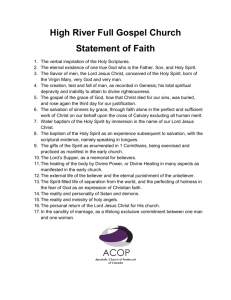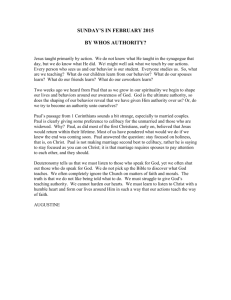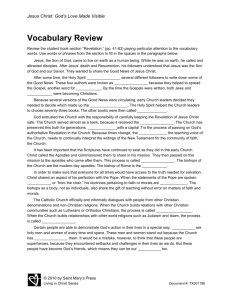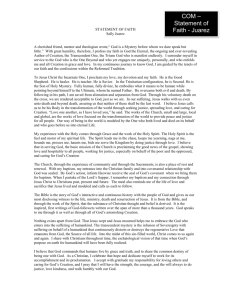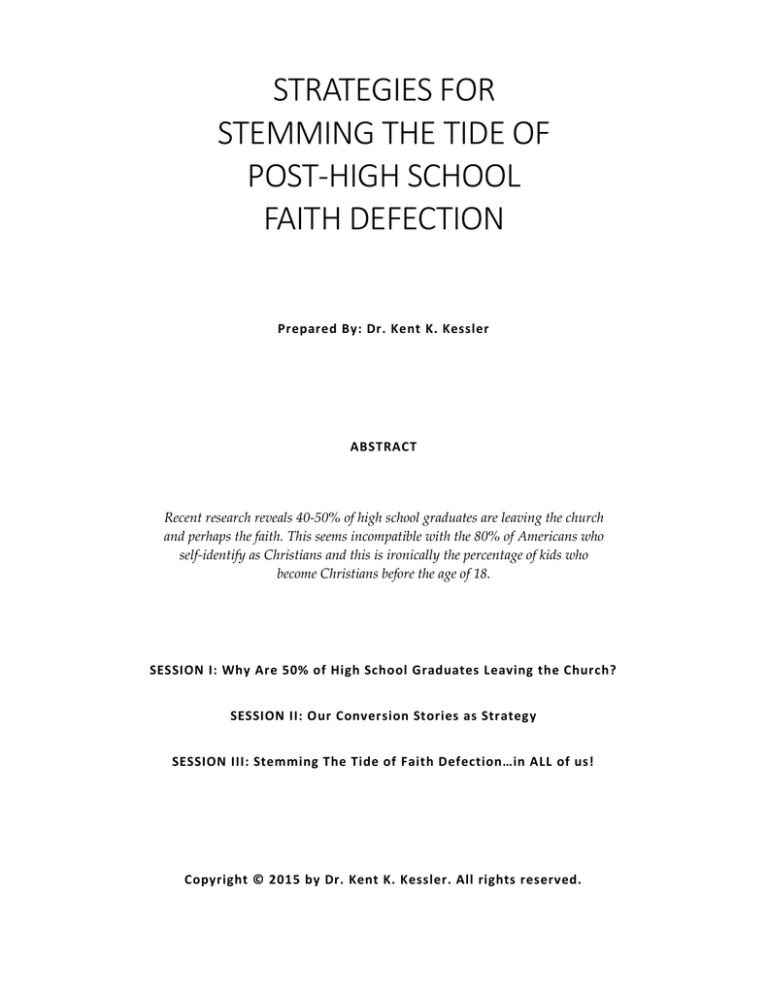
STRATEGIES FOR
STEMMING THE TIDE OF
POST-HIGH SCHOOL
FAITH DEFECTION
Prepared By: Dr. Kent K. Kessler
ABSTRACT
Recent research reveals 40-50% of high school graduates are leaving the church
and perhaps the faith. This seems incompatible with the 80% of Americans who
self-identify as Christians and this is ironically the percentage of kids who
become Christians before the age of 18.
SESSION I: Why Are 50% of High School Graduates Leaving the Church?
SESSION II: Our Conversion Stories as Strategy
SESSION III: Stemming The Tide of Faith Defection…in ALL of us!
Copyright © 2015 by Dr. Kent K. Kessler. All rights reserved.
SESSION 2: Our Conversion Stories as Strategy
Take a look at this list and place them in some order as to how you see them occurring.
______ FAITH
______ CONVICTION
______ ASSURANCE ______ CONVERSION
______ CALLING
______ SALVATION
______ BELIEF
______ JUSTIFICATION
______ CHURCH MEMBERSHIP
______ FORGIVENESS OF SINS
______ CONSIDERATION/CONTEMPLATION
______ GRACE
______ REGENERATION
______ BAPTISM
______ REPENTANCE
______ DEVOTION
______ TRUST
______ PREACHING OF THE GOSPEL
______ RECEIVING THE HOLY SPIRIT
______ SANCTIFICATION
Spiritual leaders need to know the story of God well and able to help people know where they fit
into it, so that they can teach them the language of their own conversion.
Every denomination and tradition has its own way of communicating what happens to people when
they are converted. Give me some phrases you have heard people use or you yourself use to describe it.
There is power in retelling our conversion stories.
George Barna states that 84% of American adults self-identify as Christians and adds that his
research clearly delineates (4) different types of Christians.
Not everyone who says to me, ‘Lord, Lord,’ will enter the kingdom of heaven, but the one who does the
will of my Father who is in heaven. On that day many will say to me, ‘Lord, Lord, did we not prophesy in
your name, and cast out demons in your name, and do many mighty works in your name?’ And then will
I declare to them, ‘I never knew you; depart from me, you workers of lawlessness.’ (Mt 7:21-24)
Peter (2 Pet 1:10); Paul (2 Cor 13:5). Helping people to question, test, examine, and confirm their
salvation can be a hard but necessary process on their spiritual journey—one we should not shy
away from but take very seriously, as people’s eternal souls are at stake.
Is this happening today? Could people who are committed to the church, to doing good works, to
being honest and sincere, yet be only “almost Christian” and not completely or “altogether
Christian”?
Have we been missing something—whether by example, within our teaching, within our own
experience—that we have failed to pass on as of greater importance in the faith?
● Could it be as simple as we have lost how to talk about our experiences of Christ?
● Acts 1:9, Jesus tells his disciples, “…you will be my witnesses…”
Take a look at your list and circle the numbers you placed by CONVERSION and
REGENERATION. Give you ten more seconds to finish… Now, share in a quick group of three
(with two others near you) if you had conversion before regeneration or vice versa
1
Views of Conversion (Reformed/Wesleyan/Catholic)
Renewal will come “as we embrace three
things:”
1.
A clear goal—a well-articulated,
thoroughly biblical and relevant notion of
sanctification as transformation in Christ,
capturing the longings of our hearts to be a
people who grow in holiness and become saints
as we grow older.
2.
A good beginning—a thorough and
radical conversion, for there is no sanctification
without justification, no transformation
without a complete conversion.
3. An intentional program of spiritual formation that has the clear goal of personal transformation and
builds on a good beginning—a complete conversion. (G. Smith 2001, p24)
“Scripture calls for and assumes a conversion to Jesus Christ that includes seven distinct but
inseparable elements” which are: Belief in Jesus Christ, Repentance, Trust in Jesus Christ, Transfer of
allegiance, Baptism, Reception of the gift of the Holy Spirit, Incorporation into congregational life
(Gordon Smith, Beginning Well 2001, p125).
Revivalism has made us:
1. Confuse Conversion and salvation
2. Overemphasize human volition—we think people just need to make a decision and that God
does nothing
3. See Conversion as an event
4. Anti-intellectual
5. See Conversion as an individualized transaction with God
6. Anti-sacramental
7. See Conversion as easy and painless and certainly not costly
8. See Evangelism as a technique
9. See God having grandchildren (“I’m a Christian because mom and dad were”)
10. Disconnect conversion from baptism, and the gift of the Spirit.
11. See the Church’s mission as obtaining conversions
12. Focus on the afterlife with minimal reference to this world.
We need a “new way of speaking about conversion” and about how people “come to faith.”
Our theology of conversion needs to be informed by the biblical text, the church’s tradition, and
the experience of those who come to faith, recognizing in this experience a witness to the work
of the Spirit.”
Renewal of the church won’t come through revival efforts, “but through a renewal of the nature of
conversion” –Smith.
Page | 2
The lead belief “supplanting Christianity as the dominant religion in
American churches” is called “Moralistic Therapeutic Deism.”
The five guiding beliefs of Moralistic Therapeutic Deism are:
1. A god exists who created and orders the world and watches over life on earth.
2. God wants people to be good, nice, and fair to each other as taught in the Bible and
by most world religions.
3. The central goal of life is to be happy and to feel good about oneself.
4. God is not involved in my life except when I need God to resolve a problem.
5. Good people go to heaven when they die. (Dean 2010, 14)
We have been missing something while doing church—whether by
example, within our teaching, within our own experience; we have failed
to pass on as of greatest importance the faith we possess. Or we have been
passing it on, but it just an inconsequential faith we ourselves possess.
I believe, Our Conversion Story, rightly understood and rightly
communicated, becomes the strategy God wants to use to extend His
kingdom.
And I said, “Here am I. Send me!” He said, “Go and tell this people:
“‘Be ever hearing, but never understanding; be ever seeing, but never perceiving.’ Make the heart
of this people calloused; make their ears dull and close their eyes. Otherwise they might see with
their eyes, hear with their ears, understand with their hearts, and turn and be healed.”
-- Isaiah 6:8-10
1. In Acts 2:19, Peter tells the crowd to “Repent therefore, and turn back, that your sins may be
blotted out, that times of refreshing may come from the presence of the Lord, and that he may
send the Christ appointed for you.” Peter’s response in Acts 2:38 gives some insight into a
possible pattern for conversion: “Repent and be baptized, every one of you, in the name of
Jesus Christ for the forgiveness of your sins. And you will receive the gift of the Holy Spirit.”
Steps include: 1) Repent and, 2) Be baptized in the name of Jesus Christ for, 3) The forgiveness
of your sins and you will, 4) Receive the gift of the Holy Spirit.
But there are a few preliminary details as well that contribute to Peter’s response to his hearers in the
first place. There is previously the Pentecost moment where the disciples, being obedient to Christ’s
final earthly words, were gathered in Jerusalem just as he told them to be. The promised Holy Spirit
came just as the Old Testament Prophet Joel predicted—the “this is that” moment. Peter spoke
(preached/ prophesied?) by a new authority and power and the people were “cut to the heart” and
asked, “Brothers, what shall we do?” Peter set the trap of the Gospel Story and his listeners took the
bait. So the following steps could be added to the above pattern: obedience, the Holy Spirit’s
manifestation, preaching and exposition, conviction, and inquiry/seeking, THEN: repentance,
Page | 3
baptism, to receive the remission of sins and the gift of the Holy Spirit. I like this because the whole
passage begins and ends with the Spirit.
2. When Philip engages the Ethiopian eunuch the Holy Spirit was already present and active as
the eunuch was reading in Isaiah about another man—a man who, just like him, was robbed of
his ancestry. The stage was set. An angel of the Lord gave Philip instruction and Philip was
obedient. The eunuch inquired of Philip about the Word of God. Philip revealed the truth about Page | 4
Jesus Christ. Some manuscripts say the eunuch confessed Christ, and he was baptized. The
eunuch continued “on his way rejoicing” (could be evidence of the presence of the Holy Spirit
in his life?). The Spirit is active in the soon to be convert (the eunuch was reading the Word of
God, found a point of connection, had some questions), the Spirit spoke to Philip, Philip was
obedient and the pattern continues as before (preaching and exposition, conviction, and
inquiry/seeking, then: repentance, baptism, remission of sins, and receiving the gift of the Holy
Spirit). Acts 8:26-40
3. In Acts 26:12-20, Paul shares his personal testimony and the purpose Jesus gave him as to what
his conversion would mean—“to open their eyes [of your people and the Gentiles], so that they
may turn from darkness to light and from the power of Satan to God, that they may receive the
forgiveness of sins and a place among those who are sanctified by faith in me.” Paul’s reaction
to the vision was now his testimony to King Agrippa: Therefore, O King Agrippa, I was not
disobedient to the heavenly vision, but declared first to those in Damascus, then in Jerusalem and
throughout all the region of Judea, and also to the Gentiles, that they should repent and turn
[epistrephō] to God, performing deeds in keeping with their repentance. (Acts 26:19-20)
4. Cornelius has a similar experience. The Lord speaks to Peter and an angel of God speaks to
Cornelius—the whole meeting is set up by God. Cornelius is obedient (“send for Peter”), and so
is Peter (“go with them”). Peter arrives and he inquires. Cornelius is beyond inquiry and waits
expectantly to hear what Peter has to say. Peter preaches and explains the truth about Jesus and
states, “Everyone who believes in him receives forgiveness of sins through his name.” The Holy
Spirit came upon the Gentiles and they received the gift. The Jews baptized them and enjoyed
Gentile hospitality for a few days.
5. Acts 16:14 records Lydia’s conversion with these words, “The Lord opened her heart to pay
attention to what was said by Paul,” and afterwards she and her whole household were
baptized.
6. Acts 16:25-34 recounts the Philippian jailer who fell down before Paul and Silas and asked,
“Sirs, what must I do to be saved?” and the response was, “Believe in the Lord Jesus.”
7. There is also a movement in Acts that parallels the commission of Jesus to his disciples before
He ascended—a movement from synagogue to household. Jesus said His disciples would be his
witnesses “telling people about me everywhere—in Jerusalem, throughout Judea, in Samaria,
and to the ends of the earth” (1:8 NLT). When the final conversion is recorded in Acts (18:1-8)
of Crispus, the Jewish synagogue president, he was brought to Christ in the Gentile’s Titius
Justus’ home. What a full-circle spin (Smith 2001, 48-49). Gordon Smith notes one more
movement as well—one regarding Gentile food. The converted pagan jailer invites Paul and
Silas over to eat in his house and they do. This fulfills the mission of the council’s decision in
Acts 15 “that the Gentiles do not need to become law-observant Jews in order to become
Christians” (Smith 2010, 49). It also adds another result of conversion: hospitality.
From these verses, the word epistrephō is used several times to refer to “conversion” actively involving: calling
upon the name of the LORD, seeing and hearing and understanding with the heart and turning (Isaiah),
becoming as a little child (Jesus), coming to your senses in the pigpen and getting up and returning home to your
father (prodigal son), turning back to Christ (Peter), responding to the voice of Christ (Saul), believing in the
message about Jesus (Cornelius), paying attention to the message with a God-granted opened heart (Lydia),
Page | 5
believing in the Lord Jesus (Philippian jailer), and to no longer be wandering from the truth (James).
When people “see with their eyes, hear with their ears, and understand with their hearts” they can
now “turn and be healed” just as Isaiah prophesied. The proof conversion has taken place is the
blessing of the promised Holy Spirit upon each individual and the joy He gives with one of the
results being hospitality among believers.
Jim Wallis observes how “conversion in the Bible is always firmly grounded in history; it is always
addressed to the actual situation in which people find themselves. In other words, biblical conversion is
historically specific. People are never called to conversion in a historical vacuum … Any idea of
conversion that is removed from the social and political realities of the day is simply not biblical” (1981,
5). What could a historical perspective of conversion find for us?
A Summarized Historical Perspective of Conversion
Memorizing Scriptures, maintaining a connection with the church, adhering to a three year process
for catechumenates, and using a reasoning approach in speaking with those outside the church
(primarily Greeks) until a great change took place in the history of the church and the world.
In 313 Constantine issued the Edict of Milan, “all subjects of the Empire were granted complete
freedom of worship” and Christianity became “the Imperial religion.” This seemed to be a great
triumph for the gospel, but there are victories which are as disastrous as defeats. Christendom had
entered the world.
By the 5th Century the church had practices for dealing with converts. Cyril (315-386 A.D.) was born
during the reign of Constantine. Cyril’s catechesis has survived and gives us “trustworthy evidence of
the great care” the early church had in “the instruction and training of converts, before admitting them
to the privilege of Baptism” (Gifford 1893). The contribution of Cyril's work has “a peculiar value as the
earliest extant example of a full, systematic, and continuous course of such instruction” (Gifford 1893).
For example:
On the first day we make them Christians, on the second Catechumens, on the third we exorcise
them by three times breathing on them on the face and on the ears; and so we instruct them
(katechoumen), and make them frequent the Church for a long time, and listen to the Holy
Scriptures, and then we baptize them. (Gifford 1893)
The early church developed a plan as to what to do with those who were becoming converts. They
were inaugurated into the church as “catechumens” and the plan as to how to obtain the grace God
offered unto salvation was initiated for them. Are churches doing anything similar for converts today?
1. WHAT WE NEED IS A PLAN: The Catechumen Conversion of Augustine
Augustine’s (354-430) pilgrimage brought him to a complete conversion experience where he
developed an intentional ritual formation—the catechumenate. The journey to faith involved placing a Page | 6
catechumen into a Christian community. It included four distinct stages: 2 years of instruction and
testing by being among a learning community with a personal assigned sponsor; baptismal preparation
during the season of Lent (40 days) involving renunciation of all sin and even exorcisms; the experience
of triple immersion baptism on Easter morning surrounded by the entire faith community, anointing
(chrismation) which provided acceptance to the Lord’s Table; and finally, a one week post-baptismal
instruction called the mystagogia which included instruction in the Eucharist (Smith 2010, 54-55).
Conversion in Augustine’s day included many intentional steps surrounded, instigated, and supported
by the Christian community. A liturgy for discipleship seems to have come from the inner need of
Augustine himself—he knew what he needed to come to/keep faith in Jesus Christ, and the
discipline of a catechesis guided by a liturgical process would have been counter-cultural.
Several important steps were linked with the conversion experience: instruction about Jesus Christ,
life among the Christian community, repentance of sin, confession of faith in Christ, baptism, and
anointing (laying on of hands?) as a sign of the gift of the Holy Spirit.
Augustine started something significant during this time as well: he preached out of his own
conversion experience—an authentic word made flesh. Augustine’s reflection and working through
his bad choices in life came to a place of wisdom in Christ.
One of the confusing things woven into the understanding of the Church at this time is, Conversion
meant change from membership in another Christian Church to membership in the Roman Catholic
Church” (Meagher et al. 1979, 911). “Our plan” came to mean “our church”.
2. WHAT WE NEED IS A SEPARATED COMMUNITY: Monastic Conversion of Saint Benedict
A convert in the monastic tradition is one who joins a disciplined community which lives by a
common objective marked by an ongoing conversion through intentional practices (Smith 2010, 62).
Removing converts from distractions would help them to get started on the right foot. They would
literally be taken into “the desert”—a place of spiritual solitude and reflection. Christianity was
becoming complicated so removal was necessary.
However with the simplification of the process of initiation for converts (from being three years in the
early church “to a ten-day event before Easter”) came its absence—it eventually it wasn’t required at
all. Christendom had arrived where conversion was neither expected nor called for: you were born a
Christian, you grew up a Christian, and you died a Christian.
Saint Anthony (251-356) found solitude to be the essential ingredient to true spirituality. In solitude, a
would-be convert can develop the character necessary for a relationship with Jesus Christ. Saint
Benedict of Nursia (480-547) developed a guide for sojourners in solitude for those in small groups
who would then follow his rules designed to “govern this common life around the principles of
discipline and simplicity” (Smith 2010, 58-60). This seventy-three chapter guide is known as, The Rule of
St. Benedict. Within the Rule, Benedict focused on a “daily regimen of common prayer, and meditative, Page | 7
reflective reading (lectio divina)” (Fahlbusch et al. 1999, 225).
Bernard of Clairvaux (1090-1153), the true father of monasticism, “established the Rule as the guide to
the common life of monks and promoted the Cistercian order. Through the influence of Bernard, the
monastery became a place of conversion in the midst of a compromised world” (Smith 2010, 61). The
Rule was steeped in Scripture providing the foundation for what became the basis for all Western
monasticism. Its influence is being felt still today on “new evangelical congregations that seek forms of
Christian life in fellowship that are tested, biblically based, and ecumenically open” (Fahlbusch et al.
1999, 227).
Nearly “half the monasteries of the Cistercian order were founded at sites from Scotland and Norway
to Spain and the Holy Land” (Fahlbusch et al. 1999, 229).
John Calvin, Martin Luther, and the English Reformers knew Bernard’s work and incorporated his
thoughts into their own, “not least on the governance of the church, on grace, and on Scripture”
(Fahlbusch et al. 1999, 230). The definitive text of monastic spirituality and thus of this vision of the
converted life is likely The Imitation of Christ, attributed to Thomas à Kempis” (Smith 2010, 62). The
monastic way of conversion is this: leave the world, seek God, and commune with others who are
doing the same. This is not entirely off track from the biblical perspective of conversion.
3. WE NEED AGREEMENT--The Reformers’ Example
John Calvin (1509-1564) was the one who refined and systematized doctrines. Reformers saw the
Scriptures “as the means of grace” so much so they believed “the Word actually brings about a
conversion.” One distinction here seems to be a move away from a continual searching for conversion to
a knowing one has been converted to finally the point of resting in that grace. The removal of sojourners
from the world into a solitudinous searching for conversion was replaced by the living of the converted
life in “in every sphere and sector of society” in the world (Smith 2010, 66).
Luther (1483-1546) believed “the essential marks of the church were: the Word of God, baptism,
Eucharist, the keys, the preaching office, prayer, public praise of God and thanksgiving, and the cross
and suffering” (Fahlbusch et al. 1999, 486).
Alongside the Reformers, Menno Simons (1496-1561) offers an Anabaptist perspective on conversion.
Conversion, to Simons, was a matter of “true repentance” (Smith 2010, 73). His theological interests
were published in his work entitled Fundamentboek, “Foundation of Christian Doctrine,” where he
writes about “repentance; the new birth; regeneration; rejection of the “real presence” of Christ in the
Eucharist in favor of the celebration of the supper as a memorial meal; renunciation of infant baptism
in favor of believers’, or adult baptism (Fahlbusch et al. 1999, 492). One of the distinctive marks in that
day was the belief that conversion necessitated good works as proof; “indeed, they insisted on
obedience as the fruit of faith and offered criticism of other Reformation groups who did not
emphasize the need for behavioral change” (Smith 2010, 73). This emphasis on transformation as a
part of conversion must be kept in mind. An order to salvation is also beginning to develop more
clearly.
With so much emphasis on having biblical and theological thought correct came the de-emphasis on
actual experience. Conversion to Roman Catholics meant the adoption of a creed and submission to the
authority of the Church, but to Protestants it always meant the rebirth of the soul; in the Anglican
Church regarded regeneration and conversion as independent experiences, separable in time, and
different in important aspects.
Since regeneration was mediated by baptism while conversion was seen as the deliberate turning of
the will to God and the personal acceptance of Christ by faith; conversion was becoming separated
from regeneration. A regenerated man is not necessarily a converted man.
4. WE NEED A GREAT EXPERIENCE OF GOD (Edwards and Wesley)
The fracturing of the historical Church brought with it many new developments. Parts of the Church
broke away from Rome and continued to seek Reformation. Separatists and Puritans were among them
giving winds to the sails of the evangelicalism we know today. Experience began to inform theology
more. Conversion became central, answering both the doctrinal issues of original sin, and the
experiential issues of assurance. The focus on conversion as a “definite experience” owes its effects to
the Enlightenment and Colonialism of the day. The preaching during this time often appealed to the
emotions rather than to reason.
Jonathan Edwards (1703-1758), has been called, “the most influential American-born theologian of the
18th century” and “arguably America’s greatest religious genius” who reflected much of his life in his
sermons (Fahlbusch et al. 1999, 67). Edwards’ life was “above all, dedicated to the understanding and
experience of spiritual truth, and to conveying that experience and understanding to others
(Kimnach et al. 1999, ix). Edwards is said to hold an “intensely personal spirituality of evangelical
Calvinism in the Puritan tradition” (Hart et al. 2003, 88).
To Edwards, conversion was “only the beginning of life with Christ; Christian spirituality consisted
of continued communion with him” (Hart et al. 2003, 22). Conversion arrived through a series of
mini-conversions primarily through the path of piety and renunciation of all sin. The tradition of
true Christianity came to being seen as the preaching and proclaiming of a conversion which was
personally possessed.
A major shift took place toward a more experiential religion bent by a one-sided over-emphasis on
religious affection. Controversy grew.
Page | 8
John Wesley’s (1703-1791) Aldersgate experience no doubt lead to Wesley’s “fourfold formula” for
teaching—all need to be saved, can be saved, can know that they are saved, and can be saved to the
uttermost (Watson 1984, x).
Both Wesley and George Whitefield (1714-1770) believed all needed to be converted. But Wesley took
conversion beyond its experiential determinates and placed it into organized groups so it could be
nurtured and grow. “Wherever Whitefield went he left an overwhelming impression of impassioned
eloquence; wherever Wesley went he left a company of men and women closely knit together in a
common life” (Cragg 1962, 145). Whitefield may have proved the broad nature of conversion’s event;
Wesley proved the new birth should not be orphaned but left to a methodical, mothering Church
community under God the Father.
Wherever Wesley’s “discipline was enforced, numbers rose and spiritual vitality increased” (Cragg
1962, 147). Wesley seems to have been influenced by the historical method of both the catechumen and
the monastic way of conversion and incorporated it into his “discipline.” Or the Spirit of God was
using Wesley in a cultural moment to bring what was needed for the sake of the kingdom in his day
and age. Or was it something altogether more?
It is apparent that both of these great preachers believed in conversion. Each believed God could and
would use him in the lives of others toward conversion, calling for the conversion of the souls of others
and imploring others—that is, they went for the heart of their hearers with the compelling Word of
God and with their testimony of Jesus Christ—each man in his own metaphorical way. Was this
“metaphorical way” merely an emotional appeal to people in a culture of their day or a manipulation?
Conversion has transformed much since the catechumen and the monastic forms over a century before.
Cragg takes note on how conversion changed in the minds of the people in this era. He describes the
move of the conversion experience from being centered in the Church where faith could be nurtured to
being centered on experience. “Revivalism,” Cragg records, “minimized the role of the church and
ignored the religious significance of man’s corporate life” (1962, 181). This was due to a “preoccupation
with the inner experience of each soul” with the consequences of a “deflected attention from the
political, economic, and intellectual implications of the Gospel” (1962, 181).
Some believe that the Church “is moving forward still along the channels that were cut when God
warmed Wesley’s heart” (Wood and Marshall 1996, 246). The Holiness and Pentecostal movement will
challenge us to think otherwise as the conversion “experience” takes another turn.
5. We Need a Definite Second Experience (The Holiness and Pentecostal Movements)
The waning of the Revivals awakened many questions in the Church. Once again, a discontent grew
with the way things were and a new adventure presented itself. What do we make of the lack of men
and women persevering? Why weren’t more sustaining conversions being witnessed? Could it be that
people were being brought to the line for conversion but were never stepping across? Or could it be
that conversion needs more—that people need converted, yes, but there is something after conversion
that all people need? Like the disciples, believed to be converted but lacking something until
Pentecost—was this the answer? Would something secondary provide what was seemingly missing for
the fruit of a true conversion to be witnessed? And could the Church be about this business? A man by
Page | 9
the name of John Fletcher seemed to have the answers to these questions. But the seeds of
“perfectionism” had already been sprouting around him.
Simeon the New Theologian (AD 949–1022), believed in “a further significant experience following
conversion” which he referred to as “the baptism of the Holy Spirit” when a person becomes “the
special dwelling place of God” (Fahlbusch et al. 1999, 154). The Reformers would reject perfectionism, Page | 10
but not the Anabaptists. The Pietist Philipp Jacob Spener (1633–1705), a Lutheran perfectionist, “taught
that Christians could rise to a state in which they did not sin intentionally; believers could achieve
perfection of intention but not of knowledge” (Fahlbusch et al. 1999, 154).
George Fox (1624–91) believed in the liberation from sin in the here and now. Quietists like Madame
Jean Marie Guyon (1648–1717) saw the goal of the Christian life as one of death to self and complete
love for God. These impulses from Pietism and quietism gained influence in such men as Jeremy
Taylor (1613–67) and William Law (1686–1761) who promoted the belief and experience of perfection
using such terms as the devoted life, undivided love, pure intention, and self-denial.
John Wesley (1703–1791) supplemented Taylor and Law’s perfection terminology with an “experiential
emphasis on a Pentecost-like experience” as the “normal gateway to the life of perfect love” which
became termed in Methodism as “Christian perfection” (Fahlbusch et al. 1999, 155). John Fletcher
(1729–1785) and associates took the teaching farther and replaced Wesley’s terminology with “baptism
in the Spirit” (Fahlbusch et al. 1999, 145). Fletcher taught that “adult perfect Christianity” was
“consequent upon the baptism of the Holy Ghost, administered by Christ himself” (Smith 2010, 76).
Many doctrines and churches have been built on this “Wesleyanism of John Fletcher” and have
incorporated it into their doctrinal statement. For example, Article X, paragraph 10 of The Nazarene
Church doctrinal statement:
We believe that entire sanctification is that act of God, subsequent to regeneration, by which
believers are made free from original sin, or depravity, and brought into a state of entire
devotement to God, and the holy obedience of love made perfect.
It is wrought by the baptism with or infilling of the Holy Spirit, and comprehends in one
experience the cleansing of the heart from sin and the abiding, indwelling presence of the Holy
Spirit, empowering the believer for life and service. Entire sanctification is provided by the blood
of Jesus, is wrought instantaneously by grace through faith, preceded by entire consecration; and
to this work and state of grace the Holy Spirit bears witness.
This experience is also known by various terms representing its different phases, such as
“Christian perfection,” “perfect love,” “heart purity,” “the baptism with or infilling of the Holy
Spirit,” “the fullness of the blessing,” and “Christian holiness.” (Nazarene.org, 2015)
Many churches place the roots of their history at this point and then go on to list the various changes
made to Wesley’s doctrine of perfection in the American Holiness movement. Charles G. Finney (17921875) and Thomas Upham (1799-1872) are two of the more famous Holiness leaders. The stressing of
the idea of the initial sign of speaking in tongues was evidence of the baptism was later taught by C. F.
Parham (1872-1929) who also believed that “the coming of the Spirit indicated a ‘second baptism’ in the
Holy Spirit and that speaking in tongues was the ‘Bible evidence’ of this baptism” (Hill 2006, 452).
William Seymour (1870-1922) preached Parham’s message in Los Angeles on Azusa Street and revival
broke out with signs and wonders following. Some say Seymour’s preaching “had an extraordinary
effect of a kind not witnessed in the USA since George Whitefield” (Hill 2006, 452). Those who held to a
more Presbyterian background “most notably D. L. Moody (1837-99) and R. A. Torrey (1856-1928) were
not convinced one could speak of perfection in this life” (Smith 2010, 77).
Perfection has always been a part of ecclesiology. This teaching of John Fletcher grew like fertilized
seed in North America. Three teachings regarding “Christian perfection” emerged by the 1830s: 1)
Phoebe Palmer’s (1807–74) “entire consecration” and of “laying one’s all on the metaphorical altar;”
2) “Oberlin’s perfectionism” (associated with the teachings of college president Asa Mahan (17991889) and later president Charles G. Finney (1792-1875) taught that “one could completely obey
God;” 3) “antinomian perfectionism” (of John Humphrey Noyes (1811–86), founder of the Oneida
Community) (Fahlbusch et al. 1999, 155). All of these teachings had a social element too, finding their
outlet in themes such as: antislavery, suffrage, sexual purity, pacifism, rejection of private property,
and ministries among the poor. These elements sometimes developed into new denominations such as
The Church of God (Anderson, IN), organized in 1881 by D. S. Warner (1842–1925), and the Salvation
Army, organized in 1878 by William (1829–1912) and Catherine (1829–1890) Booth—“two of the most
significant new Holiness churches” (Fahlbusch et al. 1999, 154-156).
A German Lutheran by the name of Dietrich Bonhoeffer (1906-1945) wrote The Cost of Discipleship
(1937), containing “many of the classic themes of perfectionist literature” and emphasized “the radical
call to forsake all for the way of Jesus”—a call to be heard by every Christian regardless of his or her
denominational affiliation (Fahlbusch et al. 1999, 156). Nevertheless, one of things that did happen
during this period was a bringing together of “a generation of Christians to seek a second experience
wherein they would know the grace of God’s enabling for service in the world” (Smith 2010, 77).
Summary
We’ve taken a look biblically at the seven conversion stories of Acts, followed along with the Spirit
moving people toward conversion and the historical application of emphasized beliefs at the time. I
appreciated the fact that although Christianity is reasonable and true, it is not found in discovering
wisdom and truth but by invitation to know a Person—the One who is the Truth. The soul may seek to
find peace and hope and joy in many things, but it will not find these except in the life giving waters of
Jesus Christ. As he struggled again and again, Augustine found that God would not turn away. A
personal encounter with God through the Person Jesus Christ is an absolute necessity for salvation
beginning with a turn towards Christ and Christian conversion. Wherever I find myself, the life in the
now provides all of the raw material God wishes to use in His creating me as a trophy of His grace. The
components of Augustine’s catechesis can be summarized as a given pattern through the Church
sustaining the conversion experience. The Church’s liturgical and seasonal life guided Augustine and
others in their faith-journeys, and it is still “uniquely positioned to guide this process” of conversion for
others today (Smith 2010, 85).
I appreciated the monastic approach of wanting more time to give to venturing upon the journey of
conversion with others as Christian did in John Bunyan’s Pilgrim’s Progress. The development of the
inner life is not something people slow down to give the attention needed today.
Page | 11
We need a community to help us grow and advance in our understanding of our conversion to Jesus
Christ.
The Reformers reinforced the idea that conversion is a beginning with roots firmly established in Christ
alone. The importance of the Word of God being central to our faith is also of great importance to a life
Page | 12
turning to God.
From those who brought us to the Great Awakening we have yet another aspect to our conversion—sin
must be forsaken and Christ embraced and humbly held on to. It is His love that leads to the
transformation of all His converts. It is the Holy Spirit that seals Christ’s love upon the hearts and
minds of His people—one that can be felt and known and testified to by the individual in community.
No Holy Spirit, no conversion—know the Holy Spirit, know conversion.
Our Conversion Story, rightly understood and rightly communicated, becomes the strategy
God wants to use to extend His kingdom.
Structuring Ministries toward Consequential Faith Development (Dean)
We desperately need an antidote to Moralistic Therapeutic Deism
Three Ingredients to such an antidote are learning the art-forms of: translation, testimony and
detachment. These art-forms are vital to creating a framework for consequential faith in today’s
teenager:
Missionaries know that translation, testimony, and detachment are critical tools in the missionary
toolbox. Translation is taking one form of a message and making it into another form that newcomers
to the conversation can understand. This is a time-honored missionary practice.
The Incarnation of Christ serves as our model for translation; Jesus was God’s “perfect translation,” a
perfect conversion of God’s very own self into human terms. We’re called to be translations of God’s
love as well.
“Luther was convinced that youth ministry started at home” (Dean 2010, 111). Luther believed in the
instruction of the young as a means of church renewal. “Luther developed a method of instructionby-memorization he called catechism, from catechize, to ‘echo back,’ or teach out loud” (Dean 2010, 111).
Luther’s Small Catechism, widely regarded as an educational masterpiece. It located teaching out
loud in households, not congregations, which had the effect of locating Christian formation in the
intimacy of families, where children drew direct connections between religious instruction at the
dinner table and the lives of the people who loved them. … It was an educational stroke of genius,
since it effectively ensured that parents, children, and servants learned the core teachings of the
church together. (Dean 2010, 111)
Catechesis works by evoking “trust in a person” more than trust in religious ideas” (2010, 115).
“Knowing by heart” is the means by which the “whole person” is submitted to “the ways of Christ,”
because “faith is a way of life, not just a body of information to master” (Dean 2010, 115-116).
We need to be able to communicate the faith as a way of life, not just a way to believe—a way to trust
Jesus, not just a way to believe about him (Dean 2010, 118).
Think about the Incarnation as an act of love. Without the previous generation’s translation of the
faith into the language of the next generation, the faith will stay in-house and behind the walls.
You incarnating the Word in the world before their eyes = Living Faith
Missionaries know the importance of testimony—the ability to share their faith stories with others,
even people who don’t share their point of view. Testimony requires a language for faith; it is the art
of putting our faith stories into words so we can talk about faith the way we talk about everything else
that is important in our lives.
“Youth who don’t have a language for Christ are unlikely to imagine an identity in Christ,” (2010, 142).
This is so significant. Talking about Jesus Christ actually deepens our identity as people who follow
him. Many churches have forgotten how to say what they believe!
We need to develop the practices of “spiritual apprenticeships and faith immersions where we plunge
young people into Christian “language communities” that give them “the language necessary to testify
to God’s faithfulness” (Dean 2010, 149). Church camps and mission trips and even weekend retreats
can be spaces where consequential faith is developed.
In spiritual apprenticeships, young people learn to speak Christian as apprentices in a community that
talks about Jesus, “where people testify to what it costs to love him and to love others because of him”
(Dean 2010, 151). “Teenagers learn to articulate faith by hearing adults articulate theirs = this is referred
to as the practice of “sacred eavesdropping.”
If adults cannot speak Christian any better than young people can, spiritual apprenticeship fails” (Dean
2010, 152). The dropout problem is a discipleship problem.
However, church camps, mission trips and retreats are only as effective as the guidance provided
during those times. We need to provide space for young people to articulate faith with good guidance
before, and with good debriefing after.”
These spaces as provide opportunities to make use of a “God-language” as a “decoder ring” for
teenagers in two ways: in their “immediate experience of God during the event itself” and “for
interpreting one’s life in relationship to this experience” (Dean 2010, 155). That is what Ken Pierpont
did for me! He gave me a decoder ring to interpret the God experience I was having!
Unless we can provide opportunities and space for young people to respond back out loud the faith
story they have found themselves in, “Christianity remains on mute” instead of a “good news ‘gone
Page | 13
viral’” (Dean 2010, 156). In Emmaus-like fashion, “Without a story to tell, there is no faith;” imagine
where the Church would be if it confesses the God-story for teenagers in a “run from the tomb to
tell” fashion!
The Art of Detachment is basically “the art of getting out of our own way.” Medieval mystics used the
word to describe the practice of detaching ourselves from the things that distract us from Christ, so
that we can reattach our gaze upon Christ alone. Detachment includes de-centering practices in our
life. Thirdly, what makes these camps, retreats, and mission trips so wonderful is the process of
“disentangling ourselves from whatever distracts us from Jesus Christ, so all of our attention—and
all of our lives—may be fixed upon him!”
There is significant educational value in learning to see the world from someone else’s point of view,
including seeing the world from God’s point of view. De-centering practices are a little disorienting;
they loosen our grip on what is familiar and open us to new possibilities. Like the Emmaus walkers, decentering practices involve an encounter with an “other”--in that case it was our resurrected Lord.
While we usually think of de-centering as involving things like a mission trip to another culture, the
primary de-centering practice of the church is prayer, where we take our attention off ourselves and
radically focus on God.
This practice does not come natural; this ability must be cultivated. It is a process we must learn. We
need to carve out moments when we have “decentering encounters” with God, “faithful reflexivity—a
kind of self-awareness that allows us to momentarily view ourselves and others from a new vantage
point as we watch God work” (2010, 159). Mature discipleship depends on this faithful reflexivity to
integrate into our emerging identities those experiences in which God grasps us and lets us see
ourselves and others differently” (2010, 161). This identity formation is a key issue in regards to
stemming the dropout tide.
A youth worker’s role in the church today should first come to grips that what was the pattern of
ministry to youth is no longer working.
Teenagers just aren’t coming to faith, growing in faith, or serving in faith because of a youth group or
some type of summer program. Young people meaningfully encounter the transforming love of Jesus
Christ is through their families, their congregations, and the deep investment of faithful adults who
take an interest in them (spiritual mentors).
Adapted from Kenda Creasy Dean interview article http://www.churchleaders.com/youth/youthleaders-articles/145646-almost-christian-q-a-with-kenda-creasy-dean.html
Research involving college freshman bucking the trend to “stash their identities” found that one in
seven college freshmen had what it took to avoid “the identity lockbox phenomenon” and
continued to mature in their identity formation because of their “capacity for reflexivity” (Dean
2010, 161). 85% of these (one in seven) college freshmen were what he called “religious
emissaries”—kids who had a growing awareness of others and of God.
“Most of the church’s signature practices aim for these forms of awareness,” but this artistry in
detachment, although learnable and coachable, is not teachable—we must have experiences of God
Page | 14
for ourselves (Dean 2010, 162). I strongly believe that “until we have experienced God’s engulfing
presence with us—the relationship between faith and other aspects of our lives will seem opaque
and meaningless” (2010, 162).
Having experiences of God can catapult us into thin places—those space between heaven and earth
where the detachment is needed MUST BE planned for with intentionality—children need reflective
space that frames their experience with God to who they see themselves to be and can become (Dean
2010, 166).
The Church community is very necessary to “confirm new insights” young people have in the thin
spaces we seek to create (Dean 2010, 182). Religious formation is not an accident” but instead “key
social relationships and organizations” have held significant influence in teens reporting high degrees
of religious devotion. Every Christian faith community has available to them all of the cultural tools
they need to promote consequential faith. These tools are most effective when they highlight “those
aspects of the Christian story” in THE FOLLOWING ways:
HOW TO HIGHLIGHT GOD’S STORY IN YOUR LIFE
• Focus on those aspects that speak of God’s personal and powerful nature
• Focus on the interpersonal and spiritual significance of your faith community
• Focus on righteousness/Bible teaching
• Focus on the hope that the world is ultimately in good hands
• Follow the presence of the Holy Spirit
• Focus on the “What-ifs” of God
• Resist self-focused spiritualities
Consequential faith has risks,” primarily because the gospel asks so much of teenagers that adults are
not ready for them to respond to, or at least not respond entirely. It is Christ himself who sends young
people into the world on His behalf—and the local church is to help them focus on who they are to
become to best fulfill that call.
We are called to participate in the imagination of a sending God” and this is an outer focus on the
world, not an inner focus on the church in some self-preserving or reinventing way. “The single most
important thing a church can do to cultivate missional imagination in young people is to develop
one as a church, reclaiming our call to follow Christ into the world as envoys of God’s self-giving
love” (2010, 194-195).
Researchers asked the question, “Is the frequency of how often a youth worker teaches from the Bible
associated with an attachment relationship between a youth worker and a young person” (2009, 339)?
The strongest adolescent attachments were found (73%) by those who “had leaders who taught
about Jesus through Bible study at least once per week” (Belsterling 2009, 345). The “window for
forming a sense of security in attached relationships closes quickly after adolescence,” a Church would
be wise to not "disregard the importance of ministry specifically tailored to adolescents,” because to do
so would be to “neglect the best opportunity the church has to effect fundamental change in people”
(Belsterling 2009, 349). The positive effects, both “personal and practical” of “Bible study in the context
of relational youth ministry” cannot go unnoted (Belsterling 2009, 348).
Page | 15

